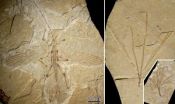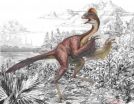(Press-News.org) The massive genome sequence of the loblolly pine — the most commercially important tree species in the United States and the source of most American paper products — has been completed by a nationwide research team, led by a UC Davis scientist.
The draft genome — approximately seven times bigger than the human genome — is the largest genome sequenced to date and the most complete conifer genome sequence ever published. The sequencing was accomplished by using, for the first time, a faster and more efficient analytical process. The achievement is described in two papers in the March 2014 issue of Genetics and in one paper in the open access journal Genome Biology.
The genome sequence will help scientists breed improved varieties of the loblolly pine, which also is being developed as a feedstock for biofuel. The newly sequenced genome also provides a better understanding of the evolution and diversity of plants.
"It's a huge genome. But the challenge isn't just collecting all the sequence data. The problem is assembling that sequence into order," said David Neale, a professor of plant sciences at the University of California, Davis, who led the loblolly pine genome project and is an author on the Genetics and Genome Biology articles.
To tackle the enormous size of the loblolly pine's genome, which until recently has been an obstacle to sequencing efforts, the research team used a new method that can speed up genome assembly by compressing the raw sequence data 100-fold.
Modern genome sequencing methods make it relatively easy to read the individual "letters" in DNA, but only in short fragments. In the case of the loblolly, 16 billion separate fragments had to be fit back together — a computational puzzle called genome assembly.
"We were able to assemble the human genome, but that was close to the limit of our ability; seven times bigger was just too much," said Steven Salzberg, professor of medicine and biostatistics at Johns Hopkins University, one of the directors of the loblolly genome assembly team and an author on the papers.
The key to the solution was using a new method, developed by researchers at the University of Maryland, which pre-processes the sequence data, eliminates redundancies and yields 100 times less sequence data. This approach, tested for the first time in this study, allowed the team to assemble a much more complete genome sequence than the draft assemblies of two other conifer species reported last year.
"The size of the pieces of consecutive sequence that we assembled are orders of magnitude larger than what's been previously published," said Neale, noting that the loblolly now provides a high-quality "reference" genome that considerably speeds along future conifer genome projects.
The loblolly genome research was conducted in an open-access manner, benefiting the research community even before the genome sequencing effort was completed and published. Data have been freely available throughout the project, with three public releases starting in June 2012.
The new sequencing confirmed that 82 percent of the loblolly genome is made up of invasive DNA elements and other DNA fragments that copied themselves around the genome. The genome sequencing also revealed the location of genes that may be involved in fighting off pathogens, which will help scientists understand more about disease resistance in pines.
For example, researchers from the Forest Service Southern Institute for Forest Genetics identified an important candidate gene for resistance to fusiform rust, the most damaging disease of southern pines. A molecular understanding of genetic resistance is a valuable tool for forest managers as they select trees that will develop into healthy stands.
"The fusiform rust mapping that our scientists did as part of this project provides significant information for land managers, since more than 500 million loblolly pine seedlings with these resistance genes are planted every year," said Dana Nelson, the institute's project leader. "The group selected loblolly pine for sequencing because of the relatively long history of genetic research from the institute and others on the loblolly's complex traits such as disease resistance," she said.
Sonny Ramaswamy, director of USDA's National Institute of Food and Agriculture, which funded the research, noted that the loblolly pine plays an important role in American forestry.
"Now that we've unlocked its genetic secrets, loblolly pine will take on even greater importance as we look for new sources of biomass to drive our nation's bio-economy, and ways to increase carbon sequestration and mitigate climate change," Ramaswamy said.
The loblolly genome project was led by a UC Davis team, and the assembly stages were led by Johns Hopkins University and the University of Maryland. Other collaborating institutions include Indiana University, Bloomington; Texas A&M University; Children's Hospital Oakland Research Institute; and Washington State University.
INFORMATION:
The work was supported in part by the US Department of Agriculture's National Institute of Food and Agriculture through its flagship competitive grants program, the Agriculture and Food Research Initiative.
About UC Davis:
For more than 100 years, UC Davis has been one place where people are bettering humanity and our natural world while seeking solutions to some of our most pressing challenges. Located near the state capital, UC Davis has more than 33,000 students, over 2,500 faculty and more than 21,000 staff, an annual research budget of over $750 million, a comprehensive health system and 13 specialized research centers. The university offers interdisciplinary graduate study and more than 100 undergraduate majors in four colleges — Agricultural and Environmental Sciences, Biological Sciences, Engineering, and Letters and Science. It also houses six professional schools — Education, Law, Management, Medicine, Veterinary Medicine and the Betty Irene Moore School of Nursing.
Media contact(s):
-- David Neale, UC Davis Plant Sciences, dbneale@ucdavis.edu
-- Jennifer Martin, USDA National Institute of Food and Agriculture, (202) 720-8188, jmartin@nifa.usda.gov
-- Cristy Gelling, Genetics Society of America, (412) 327-6343, cgelling@thegsajournals.org
-- Anna Perman, Genome Biology/BioMed Central, +44 (0)20 3192 2, Anna.Perman@biomedcentral.com
-- Pat Bailey, UC Davis News Service, (530) 752-9843, pjbailey@ucdavis.edu
Loblolly pine's immense genome conquered
2014-03-20
ELSE PRESS RELEASES FROM THIS DATE:
Safety first, children
2014-03-20
VIDEO:
A mother and child discuss whether a scenario is dangerous, for a new study by the University of Iowa examining how parents can keep their children safe.
Click here for more information.
As parents, we've all been there: Watching our children teeter on a chair, leap from the sofa, or careen about the playground, fearing the worst. And, we all wonder, how can we teach them to be safer?
Such was the goal of a team of researchers at the University of Iowa, who analyzed in ...
Tiny transistors for extreme environs
2014-03-20
SALT LAKE CITY, March 20, 2014 – University of Utah electrical engineers fabricated the smallest plasma transistors that can withstand high temperatures and ionizing radiation found in a nuclear reactor. Such transistors someday might enable smartphones that take and collect medical X-rays on a battlefield, and devices to measure air quality in real time.
"These plasma-based electronics can be used to control and guide robots to conduct tasks inside the nuclear reactor," says Massood Tabib-Azar, a professor of electrical and computer engineering. "Microplasma transistors ...
Where are we with breast cancer in 2013?
2014-03-20
The global burden of breast cancer remains immense in 2013, with over 1.6 million new cases being diagnosed annually. This burden has been increasing at a rate of 3.1% per year, and while the majority of new cases are diagnosed among women in developed countries, the 450,000 deaths per year from the disease are now equally divided between the developing and developed world, the 9th European Breast Cancer conference (EBCC-9) will hear tomorrow (Friday).
Professor Peter Boyle, Director of the University of Strathclyde Institute of Global Public Health at the International ...
Choice of GP practice pilot most popular with young commuters and patients moving home
2014-03-20
A pilot scheme allowing patients to visit GPs outside the area they live in was most popular among younger commuters and people who had moved house but did not want to change their GP, according to a new report by the London School of Hygiene & Tropical Medicine.
The Department of Health's Choice of GP pilot scheme found that while demand overall was modest, participants were generally positive about the scheme and there was little sign of major increased cost to primary care trusts (PCTs) for providing the service. Patients will be able to register with volunteer practices ...
Future heat waves pose threat to global food supply
2014-03-20
Heat waves could significantly reduce crop yields and threaten global food supply if climate change is not tackled and reversed.
This is according to a new study led by researchers at the University of East Anglia and published today, 20 March, in IOP Publishing's journal Environmental Research Letters, which has, for the first time, estimated the global effects of extreme temperatures and elevated levels of carbon dioxide (CO2) on the production of maize, wheat and soybean.
Earlier studies have found that climate change is projected to reduce maize yields globally ...
Data on antibiotic use in non-EU countries should stimulate development of action plans
2014-03-20
A new study, published in The Lancet Infectious Diseases journal, provides the first ever reliable data on antibiotic use in non-European Union (EU) southern and eastern European countries and newly independent states.
The research, which was led by Dr Herman Goossens, of the Vaccine and Infectious Disease Institute (VAXINFECTIO) at the University of Antwerp, Belgium, is a critical first step in identifying targets for improvements in the way antibiotics are used in these countries. The authors hope that the findings will aid the development of national action plans ...
Fossils of earliest stick insect to mimic plants discovered
2014-03-19
An ancient stick insect species may have mimicked plant leaves for defense, according to a paper published in the open-access journal PLOS ONE on March 19, 2014 by Maomin Wang, from Capital Normal University, China and colleagues.
Many insects have developed defense mechanisms, including the ability to mimic the surrounding environment. Stick and leaf insects mimic plants from their environment, but scientists know little about the original of this interaction due to little or no previous stick insect fossil records showing this adaptation. The scientists discovered three ...
Large feathered dinosaur species discovered in North America
2014-03-19
Fossils found in western North America reveal a new species of large-bodied, feathered oviraptorosaurian theropod dinosaur from the latest Cretaceous Period, according to a paper published in the open-access journal PLOS ONE on March 19, 2014 by Matthew Lamanna from Carnegie Museum of Natural History in Pennsylvania and colleagues.
Known for their beaks, long necks, and relatively short tails, the bird-like oviraptorosaurian group contains dinosaurs with body sizes ranging from a few kilograms to more than one metric ton. The scientists described three well-preserved partial ...
Fossilized bighorn sheep poop reveals early Holocene population
2014-03-19
Genetic analysis of ancient poop found off the coast of Mexico suggests bighorn sheep may be native to the island, according to a paper published in the open-access journal PLOS ONE on March 19, 2014 by Benjamin Wilder from University of California Riverside and colleagues.
Bighorn sheep were not thought to inhabit Tiburón Island, the largest island in the Gulf of California and Mexico, prior to their introduction in 1975. Scientists discovered fossilized dung in the mountains of Tiburón Island that challenges that assumption. Scientists compared the pellet-shaped poop ...
Bighorn sheep went extinct on desert island in Gulf of California, study finds
2014-03-19
RIVERSIDE, Calif. — Using ancient DNA analysis and other techniques, a research team led by conservation biologists at the University of California, Riverside has determined that bighorn sheep, so named for their massive spiral horns, became extinct on Tiburón Island, a large and mostly uninhabited island just off Sonora, Mexico, in the Gulf of California, sometime in the last millennium — specifically between the 6th and 19th centuries.
The result, published March 19 in PLOS ONE, is a surprise because conventional wisdom among wildlife biologists and the indigenous Seri ...






